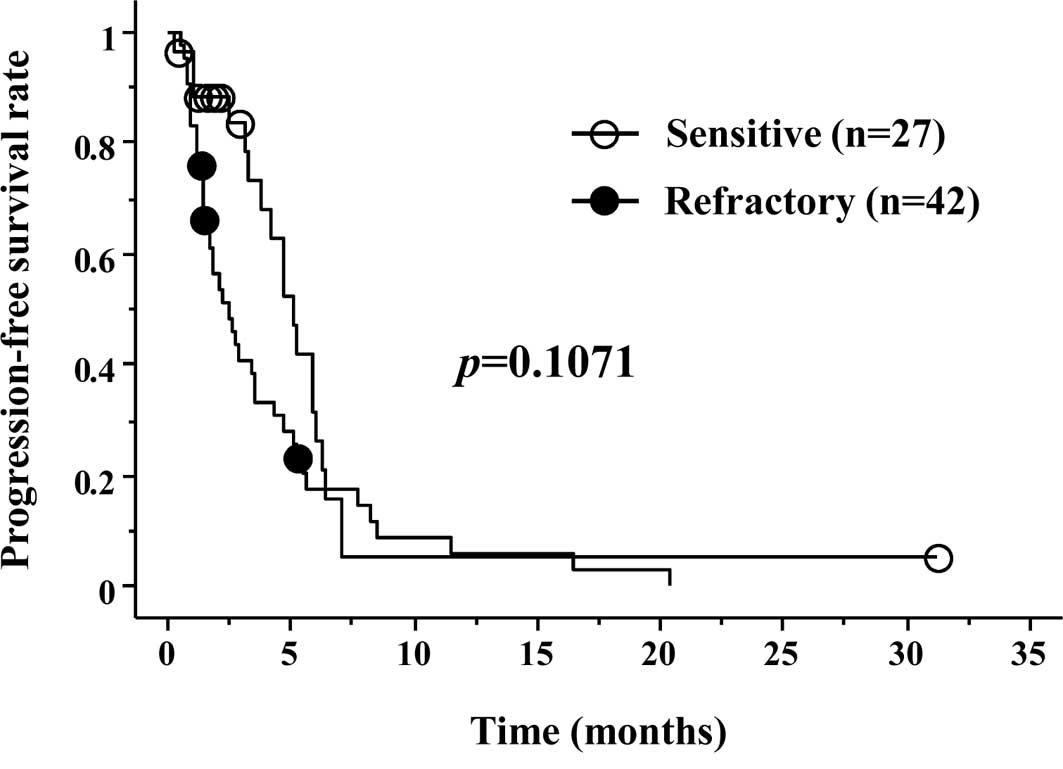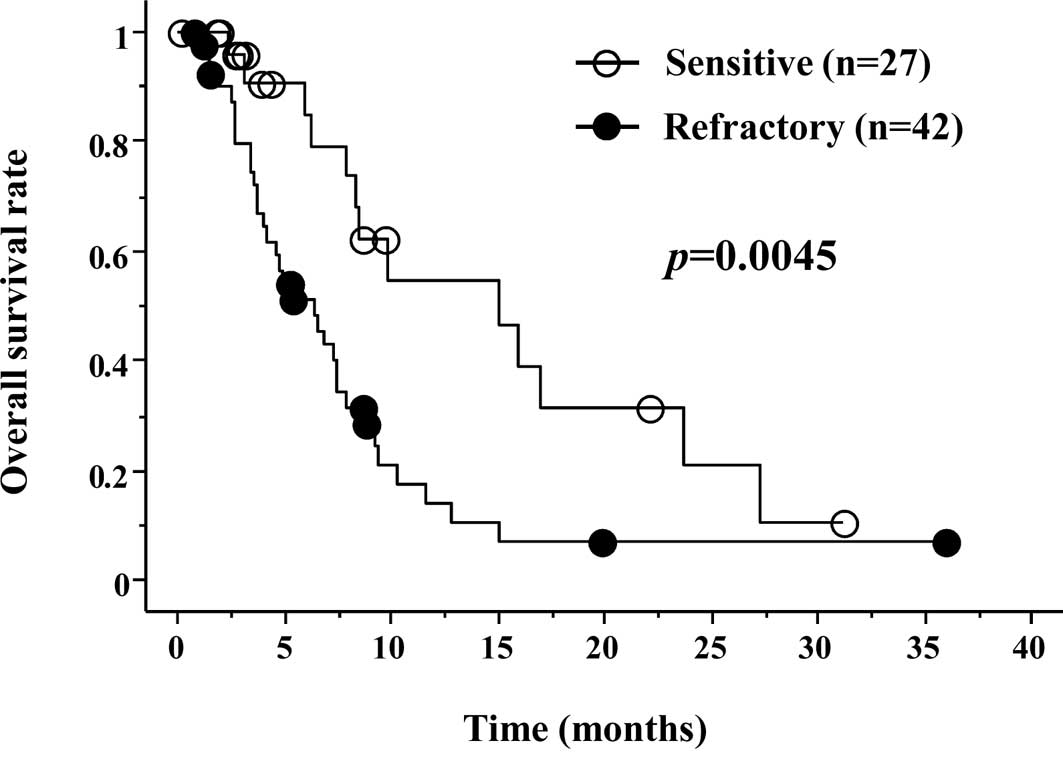Retrospective analysis of Japanese patients with relapse or refractory small-cell lung cancer treated with amrubicin hydrochloride
- Authors:
- Young H. Kim
- Tadashi Mio
- Katsuhiro Masago
- Kaoru Irisa
- Yuichi Sakamori
- Michiaki Mishima
-
View Affiliations
Affiliations: Department of Respiratory Medicine, Graduate School of Medicine, Kyoto University, Kyoto 606-8507, Japan. ekim@kuhp.kyoto-u.ac.jp
- Published online on: May 1, 2010 https://doi.org/10.3892/ol_00000101
-
Pages:
569-572
Metrics:
Total
Views: 0 (Spandidos Publications: | PMC Statistics:
)
Metrics:
Total PDF Downloads: 0 (Spandidos Publications: | PMC Statistics:
)
This article is mentioned in:
Abstract
Amrubicin (AMR) is one of the most active chemotherapeutic agents for small-cell lung cancer (SCLC). Previous phase II studies reported on its effectiveness and severe hematological toxicities. However, AMR has yet to be approved outside Japan. Subsequently, no extensive evidence of its effects exist. Between January 2004 and October 2009, 69 patients received AMR for relapsed SCLC at our hospital. We reviewed these patients, and analyzed the efficacy and hematological toxicities of AMR. There were 27 sensitive relapses (S) and 42 refractory relapses (R). Patients received platinum agents, and 43 and 71% of the patients received etoposide and irinotecan, respectively. The median number of treatment cycles was 3 (range 1-14), and the response rate was 51% (70% in the S and 38% in the R cases, respectively). In patients administered with AMR as second-line therapy, the response rate was 55% and as third-line therapy, 39%. Median progression-free survival time was 3.2 months in the S and 1.9 months in the R patients (p=0.1071). Median survival time from the start of AMR was 6.2 months in the S and 4.8 months in the R cases (p=0.0045). The frequency of grade ≥3 hematological toxicities was leukopenia (41%), neutropenia (51%), anemia (14%), thrombocytopenia (17%) and febrile neutropenia (12%). No treatment-related death was observed. Although hematological toxicities, particularly neutropenia, were severe, AMR showed excellent anti-tumor activity, not only in the S, but also in the R cases, as shown in previous phase II studies. These results warrant further evaluation of AMR in the second-line setting, and also in the first-line setting in both limited- and extensive-stage disease. We conducted a phase II study to assess the efficacy of consolidation chemotherapy with AMR after standard chemoradiation in limited-stage SCLC.
View References
|
1
|
Jackman DM and Johnson BE: Small-cell lung
cancer. Lancet. 366:1385–1396. 2005. View Article : Google Scholar : PubMed/NCBI
|
|
2
|
O’Brien ME, Ciuleanu TE, Tsekov H, et al:
Phase III trial comparing supportive care alone with supportive
care with oral topotecan in patients with relapsed small-cell lung
cancer. J Clin Oncol. 24:5441–5447. 2006.PubMed/NCBI
|
|
3
|
Von Pawel J, Schiller JH, Shepherd FA, et
al: Topotecan versus cyclophosphamide, doxorubicin and vincristine
for the treatment of recurrent small-cell lung cancer. J Clin
Oncol. 17:658–667. 1999.PubMed/NCBI
|
|
4
|
Inoue K, Ogawa M, Horikoshi N, et al:
Phase I and pharmacokinetic study of SM-5887, a new anthracycline
derivative. Invest New Drugs. 7:213–218. 1989.PubMed/NCBI
|
|
5
|
Negoro S, Fukuoka M, Nakamura S, et al:
Phase I-II study of amrubicin (SM-5887), a novel
9-aminoanthracycline, by iv administration for 3 consecutive days
in patients with advanced non-small cell lung cancer. Proc Am Soc
Clin Oncol. 14:3611995.
|
|
6
|
Yana T, Negoro S, Takada M, et al: Phase
II study of amrubicin in previously untreated patients with
extensive-disease small cell lung cancer: West Japan Thoracic
Oncology Group (WJTOG) study. Invest New Drugs. 25:253–258. 2007.
View Article : Google Scholar : PubMed/NCBI
|
|
7
|
Onoda S, Masuda N, Seto T, et al: Phase II
trial of amrubicin for treatment of refractory or relapsed
small-cell lung cancer: Thoracic Oncology Research Group Study
0301. J Clin Oncol. 24:5448–5453. 2006. View Article : Google Scholar : PubMed/NCBI
|
|
8
|
Kato T, Nokihara H, Ohe Y, et al: Phase II
trial of amrubicin in patients with previously treated small cell
lung cancer (SCLC). Proc Am Soc Clin Oncol. 24:70612006.
|
|
9
|
Inoue A, Sugawara S, Yamazaki K, et al:
Randomized phase II trial comparing amrubicin with topotecan in
patients with previously treated small-cell lung cancer: North
Japan Lung Cancer Study Group Trial 0402. J Clin Oncol.
26:5401–5406. 2008. View Article : Google Scholar : PubMed/NCBI
|
|
10
|
Therasse P, Arbuck SG, Eisenhauer EA, et
al: New guidelines to evaluate the response to treatment in solid
tumors. European Organization for Research and Treatment of Cancer,
National Cancer Institute of the United States, National Cancer
Institute of Canada. J Natl Cancer Inst. 92:205–216. 2000.
View Article : Google Scholar
|
|
11
|
Simon GR and Turrisi A: Management of
small cell lung cancer: ACCP evidence-based clinical practice
guidelines (2nd edition). Chest. 132:S324–S339. 2007. View Article : Google Scholar
|
|
12
|
Kim YH, Goto K, Yoh K, et al: Performance
status and sensitivity to first-line chemotherapy are significant
prognostic factors in patients with recurrent small cell lung
cancer receiving second-line chemotherapy. Cancer. 113:2518–2523.
2008. View Article : Google Scholar : PubMed/NCBI
|
|
13
|
Igawa S, Yamamoto N, Ueda S, et al:
Evaluation of the recommended dose and efficacy of amrubicin as
second- and third-line chemotherapy for small cell lung cancer. J
Thorac Oncol. 2:741–744. 2007. View Article : Google Scholar : PubMed/NCBI
|












